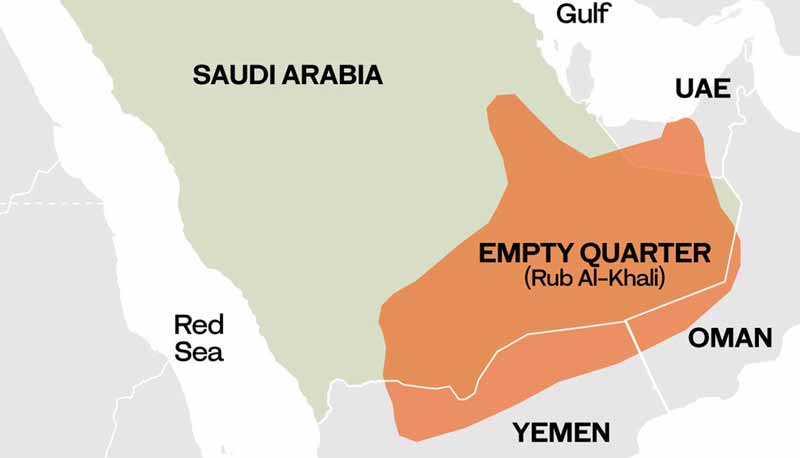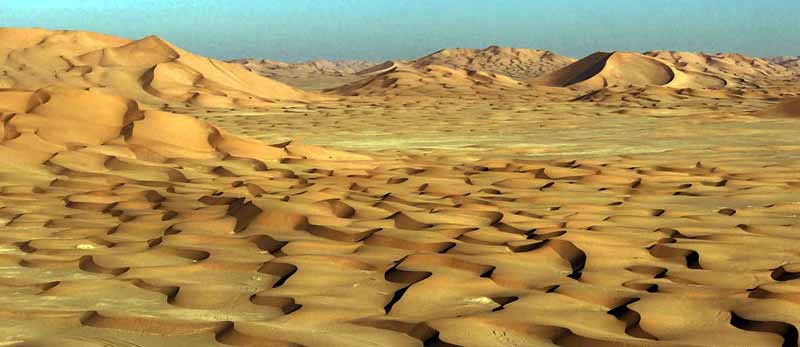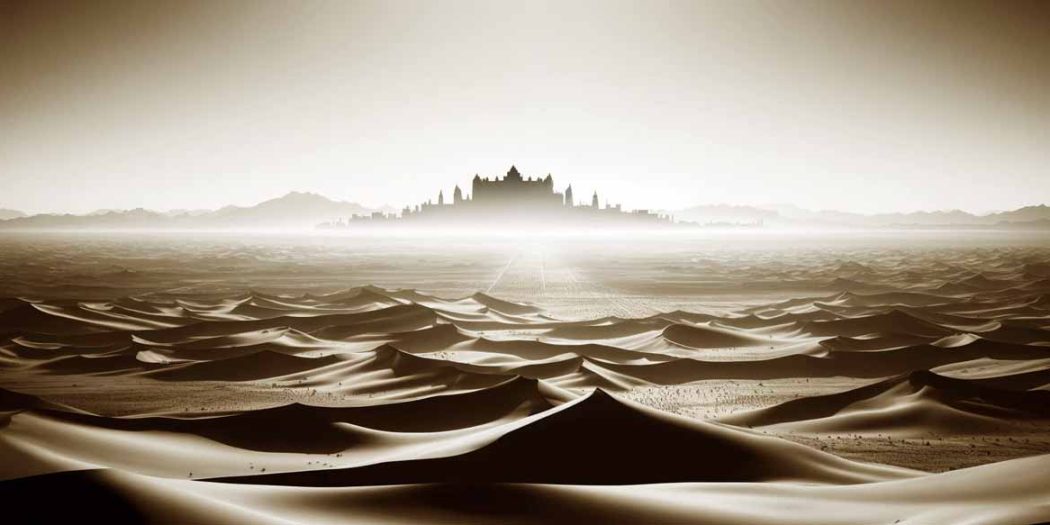Once upon a time, there was a beautiful green land shimmering with the waters of blue lakes where hippos played and deer frolicked on the banks under the shade of lush and towering trees. Then, suddenly, something terrible happened that turned those green plains into barren deserts. The grass and beautiful wildflowers disappeared, replaced by scorching sands that gradually eradicated all forms of life, earning this land the deserved name of the Empty Quarter. It is a dreadful desert that harbors many mysteries and secrets beneath its sands, the most famous of which is the mystery of “Ubar,” the lost city also known as “the Atlantis of the Desert.”
The Empty Quarter (Rub al-Khali Desert) is the largest sand desert in the world, located in the southwestern part of the Arabian Peninsula and covering an area of 650,000 square kilometers, equivalent to the combined area of France, Belgium, and the Netherlands. This desert spans four countries: the Kingdom of Saudi Arabia, which hosts the largest portion of the desert within its borders, the United Arab Emirates, the Sultanate of Oman, and the Republic of Yemen. It is called the Empty Quarter because it is almost devoid of life, being one of the harshest places on Earth in terms of climatic conditions. In summer, temperatures can exceed 55 degrees Celsius, and it is covered by sand dunes, some of which reach heights of over 200 meters. The only form of life in this desert consists of some plants, spiders, birds, and small rodents. As for humans, there are only a few nomadic tribes that live on the fringes of the desert and avoid venturing deep into it.

For centuries, the expanse of this desert remained unknown, surrounded by legends and myths, with no one daring to breach its infernal gates. However, in 1932, the Englishman Bertram Thomas undertook the first documented journey to cross the desert, during which he discovered some of its regions and studied its plants and the small creatures living in it. During this journey, Thomas heard for the first time about the story of “Ubar,” the lost city, while being hosted in the tents of the Bedouins living on the edges of the desert. Although Bertram mentioned this story in his book about the desert, he probably did not take it seriously. However, this story ignited the enthusiasm and greed of another Englishman, the British intelligence agent John Philby, who undertook several exploratory journeys to search for “Ubar” since 1932. Unfortunately for Philby, or Sheikh Abdullah as he called himself, he did not find any trace of the lost city. Instead, he discovered something important: among the sand dunes, he saw traces of white limestone layers that appeared to be deposits of ancient water bodies, and he discovered skeletal remains of animals, including hippopotamus teeth, which puzzled him. What were hippos, creatures that live in and near water, doing in the barren Empty Quarter Desert?
This puzzling question had only one answer: the white limestone layers were nothing but remnants of water lakes that existed in the desert in ancient times. This conclusion was confirmed by many scientists and geologists who studied the region in the following decades. Additionally, the discovery of vast amounts of oil in the middle of the desert supported this hypothesis, as oil is formed from the remains of organic matter buried underground, confirming the richness of the Empty Quarter Desert in plant and animal life in ancient times.
The latest theories about the history of the Empty Quarter suggest that the region experienced two periods characterized by moderate temperatures and increased rainfall, leading to the flourishing of plant and animal life. The first period lasted from 37,000 to 17,000 years ago, and the second period lasted from 10,000 to 5,000 years ago, meaning that the great drought occurred around 3,000 BC. If this theory is true, it would solve a major historical mystery regarding the migration of some Semitic peoples. At the beginning of the third millennium BC, there was a significant human migration from the Arabian Peninsula, headed north towards north. We are not here to discuss the historical events that accompanied these migrations, but what matters in this context is the question of what caused the sudden and simultaneous migration. The answer undoubtedly lies in the weather and climate, which changed significantly five thousand years ago. The green lands, which were similar to the rainforests of India and covered the land of the Arabian Peninsula, turned into barren deserts, forcing a large proportion of the population to migrate northward. Perhaps all that remained of their life in the Arabian Peninsula were memories that the Arabs shared in the form of stories about the extinct Arab tribes, known as the “perished Arabs.”
Of course, this is just a hypothesis, as scientists differ among themselves on whether the great Semitic migrations to the Mesopotamian Valley and the Levant came from Arabian Peninsula or from another place.

Regardless of the ongoing debate, it is almost agreed that one of the most famous extinct ancient Arab tribes or peoples is the people of ‘Ad, mentioned in the Holy Quran:
“Then as for ‘Ad, they were arrogant upon the earth without right, and they said, ‘Who is mightier than us in strength?’ Did they not see that Allah, who created them, was mightier than them in strength? And they used to deny Our signs. So We sent upon them a screaming wind in unlucky days to make them taste the punishment of disgrace in the worldly life, but the punishment of the Hereafter is more disgraceful, and they will not be helped.” (Surah Fussilat: 15-16)
The dwellings of ‘Ad were located in the southern part of the Empty Quarter, north of Hadramout. They were extremely wealthy and prosperous, and this is not a myth. Their wealth did not fall from the sky but was due to their control over the trade of Arabian frankincense (gum), which they exported to the Levant and Egypt through trade routes passing through the Empty Quarter Desert. They had several large cities, perhaps the most famous of which was “Ubar” or “Iram of the Pillars,” which was mentioned in ancient historical writings in Yemen and some ancient writings of Greek historians, confirming its existence.
The people of ‘Ad disappeared suddenly from the face of the earth around the 4th century BC, and their prosperous cities vanished with them. All that remained were legendary stories passed down through tongues, which historians considered mere myths with no basis in truth. However, what happened in the 1980s turned these myths into a tangible reality. Satellites detected the ancient caravan routes passing through the Empty Quarter towards the north. When scientists followed the course of this road leading from the south to the Sultanate of Oman, they reached a small oasis, and nearby they saw the remains of an ancient fort. Initially, they thought the fort was of recent construction, dating back to several centuries ago. However, as they began to excavate the site, they discovered Greek, Roman, and Pharaonic pottery and jars dating back thousands of years, and they began to wonder: did they discover “Ubar,” the lost city?
The walls of the fort were thick, three meters high, with eight massive watchtowers. It seems that the fort or small city met a tragic end sometime in the first or second century AD. The ground beneath it sank, as it appears to have been built on a limestone layer covering a huge underground water cavern, which the residents and caravans used for drinking water. However, it happened that the water level in this natural reservoir decreased, causing the ground to collapse under the fort unexpectedly. Despite the significance of this discovery, most scientists today do not believe that this fort is the remains of the city of “Ubar” or “Iram of the Pillars.” Instead, they suggest it was just a resting place for caravans passing through the desert and that the land of the people of ‘Ad contained many forts and cities, like all great civilizations. Most of these great cities are still buried under tons of desert sand, waiting for someone to unearth them, and only God knows what treasures and secrets they hide.
 kabbos
kabbos




